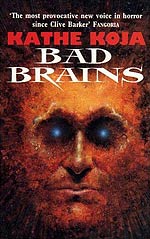
![]() charlesdee
charlesdee
1/2/2016
![]()
One evening, while in a bad mood, Austen Bandy has a run in with an irritating liquor store clerk and does a dumb thing on the way out the door. His mocking little bow to the woman sends him tripping off the curb. Weeks, maybe months later, he remains in hospital suffering from frontal lobe seizures. When the drugs finally get the seizures under control, he encounters for the first time the spreading silver mass that slides off the edges of mirrors or lurks in the corners of rooms, always ready to engulf his world. But Austen has had enough of hospitals and doctors and so he keeps quiet about this little issue. His scans are coming in clear, no more seizures, he is ready to go home.
Austen is not ready to go home. He is a failing artist still obsessed with his ex-wife. He apparently has no friends. The medical bills have impoverished him. And that thing in the corner or in the drains or along the frosted side of a beer can may be just an hallucination but it is a very dangerous one. Austen does not want to be labeled crazy, and so he makes lots of bad decisions, mainly the decision to just deal with this on his on.
Koja's claustrophobic prose can be either lyrical or as disturbing as Austen's hallucinations and the behavior they produce. In a story where the action will become increasingly deranged, the physical settings have to remain concrete and believable. Koja moves the reader from crummy apartments to cheap motels, public restrooms and the home of a brujo somewhere in the northern midwest and keeps each locale specific and real. The novel is a fever dream that for Austen and those he brings into his world can cause serious damage. Is this a horror novel, or just what kind of horror novel can have a color as its monster? Well in one scene the silver sheen opens Austen's skull and reveals of nest of eyeballs in his brain. So I would say, yes this is a horror novel and the monster means business. Readers with a low tolerance for vomiting should be warned away from this book.